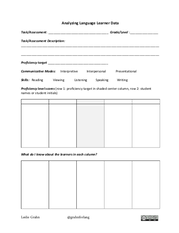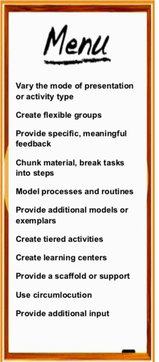Responding to Student Data
|
| ||||||||||||||||
Responding to pre-assessment data (ex. KWL, entrance slips, corners, stickie notes, graphic organizers, etc.)
1. Compact content of lesson
2. Address misconceptions
3. Make connections to students' prior experiences/learning
4. Create flexible groups
5. Use questioning to identify learning gaps
6. Adjust pace of lesson
Responding to whole class formative assessment data during the learning experience (ex. thumbs up/thumbs down, whiteboards, pinch cards, clickers, observational data, etc.)
1. Vary the mode of presentation or activity type.
2. Create small groups and have students work together using cooperative learning structures
3. Offer an additional, more personalized formative assessment to get more specific data on student needs
4. Address misconceptions, errors
5. Use questioning to identify learning gaps
6. Teach mnemonic devices
7. Chunk material
8. Peer tutoring/ buddies
9. Respond to patterns and trends
10. Connect new learning to previous content/units
11. Provide additional models or exemplars
12. Break tasks/concepts into steps
13. Make real world connections
14. Explain your thinking process through a Think Aloud or other metacognitive strategy
Responding to individual and whole group formative data
between learning experiences (ex. exit slips, 3-2-1, classwork assignments, warm-ups, etc.)
1. Switch the modality of an existing activity
2. Create tiered activities based on readiness levels (scaffolded for lower tier to added challenge/rigor/depth for highest tier)
3. Create readiness or mixed readiness groupings
4. Create learning centers
5. Offer choices through strategies like choice boards and RAFT assignments
6. Connect new learning to previous content/units
7. Vary materials and resources
8. Engage students in an academic game
9. Follow-up with a graphic organizer
10. Provide anchor activity or complete a learning contract
11. Customize rubrics for student growth
12. Provide specific feedback on progress
Additional data to consider:
1. Use student self-reflection and self-assessment data
2. Use qualitative data from students on their perception of their learning, what strategies work best for them, etc.
3. Use data about student learning preferences (learning style, multiple intelligences) and interest
Suggestions from James Popham in his book, Transformative Assessment in Action: An Inside Look at Applying the Process (ASCD, 2011)
1. Immediate instructional adjustments based on assessed performance
2. Immediate instructional adjustments based on student-reported understanding
Choice points:
1. What kind of assessment tool to use
2. When to collect assessment evidence
3. How to help students more accurately self-assess their understanding
4. When to make an instructional adjustment
5. What kind of instructional adjustment to make
6. How to help students more honestly report their understanding and surface misconceptions
Possible responses to this type of data:
• teacher has a "plan B"/alternate activity
• explains it again differently*** (strategy used most often)
• peer tutoring/group sharing
• differentiate the modality of the practice
• uses questioning to get more specific data on gaps in understanding
3. Near-future instructional adjustments
4. Last-chance instructional adjustments
5. Students' learning tactic adjustments
6. Classroom climate shifts
1. Compact content of lesson
2. Address misconceptions
3. Make connections to students' prior experiences/learning
4. Create flexible groups
5. Use questioning to identify learning gaps
6. Adjust pace of lesson
Responding to whole class formative assessment data during the learning experience (ex. thumbs up/thumbs down, whiteboards, pinch cards, clickers, observational data, etc.)
1. Vary the mode of presentation or activity type.
- activities for bodily-kinesthetic learners
- activities for visual-spatial learners
- activities for musical-rhythmic learners
2. Create small groups and have students work together using cooperative learning structures
3. Offer an additional, more personalized formative assessment to get more specific data on student needs
4. Address misconceptions, errors
5. Use questioning to identify learning gaps
6. Teach mnemonic devices
7. Chunk material
8. Peer tutoring/ buddies
9. Respond to patterns and trends
10. Connect new learning to previous content/units
11. Provide additional models or exemplars
12. Break tasks/concepts into steps
13. Make real world connections
14. Explain your thinking process through a Think Aloud or other metacognitive strategy
Responding to individual and whole group formative data
between learning experiences (ex. exit slips, 3-2-1, classwork assignments, warm-ups, etc.)
1. Switch the modality of an existing activity
- activities for bodily-kinesthetic learners
- activities for visual-spatial learners
- activities for musical-rhythmic learners
2. Create tiered activities based on readiness levels (scaffolded for lower tier to added challenge/rigor/depth for highest tier)
3. Create readiness or mixed readiness groupings
4. Create learning centers
5. Offer choices through strategies like choice boards and RAFT assignments
6. Connect new learning to previous content/units
7. Vary materials and resources
8. Engage students in an academic game
9. Follow-up with a graphic organizer
10. Provide anchor activity or complete a learning contract
11. Customize rubrics for student growth
12. Provide specific feedback on progress
Additional data to consider:
1. Use student self-reflection and self-assessment data
2. Use qualitative data from students on their perception of their learning, what strategies work best for them, etc.
3. Use data about student learning preferences (learning style, multiple intelligences) and interest
Suggestions from James Popham in his book, Transformative Assessment in Action: An Inside Look at Applying the Process (ASCD, 2011)
1. Immediate instructional adjustments based on assessed performance
2. Immediate instructional adjustments based on student-reported understanding
Choice points:
1. What kind of assessment tool to use
2. When to collect assessment evidence
3. How to help students more accurately self-assess their understanding
4. When to make an instructional adjustment
5. What kind of instructional adjustment to make
6. How to help students more honestly report their understanding and surface misconceptions
Possible responses to this type of data:
• teacher has a "plan B"/alternate activity
• explains it again differently*** (strategy used most often)
• peer tutoring/group sharing
• differentiate the modality of the practice
• uses questioning to get more specific data on gaps in understanding
3. Near-future instructional adjustments
4. Last-chance instructional adjustments
5. Students' learning tactic adjustments
6. Classroom climate shifts


